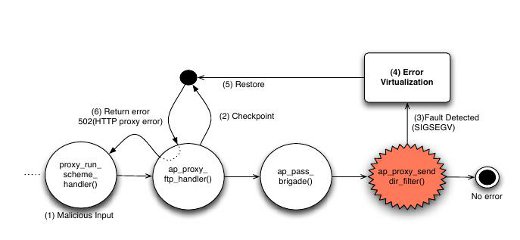|
Software failures in server applications are a significant
problem for preserving system availability. ASSURE introduced rescue points to recover
software from unknown faults, while maintaining both system
integrity and availability, by mimicking system behavior under known
error conditions.
Rescue points are locations in existing application
code for handling a given set of
programmer-anticipated failures, which are automatically
repurposed and tested for safely enabling fault recovery
from a larger class of (unanticipated) faults.

Example of rescue point
REASSURE builds on Intel's Pin DBI framework to provide a self-containted
mechanism to head software using rescue points. Rescue points can be identified
and tested as before, and finally deployed using Pin and REASSURE. This new
approach does not require special kernel support, and can be applied on already
deployed binaries simply be installing Pin, and attaching it to the faulty
application.
People
Prof. Angelos Keromytis, Columbia University
Georgios Portokalidis, Columbia University
Related papers
|
REASSURE: A Self-contained Mechanism for Healing Software Using
Rescue Points [PDF] |
| Georgios Portokalidis and Angelos D. Keromytis |
|
In Proceedings 6th International Workshop on Security
(IWSEC2011), November 2011. |
| 

